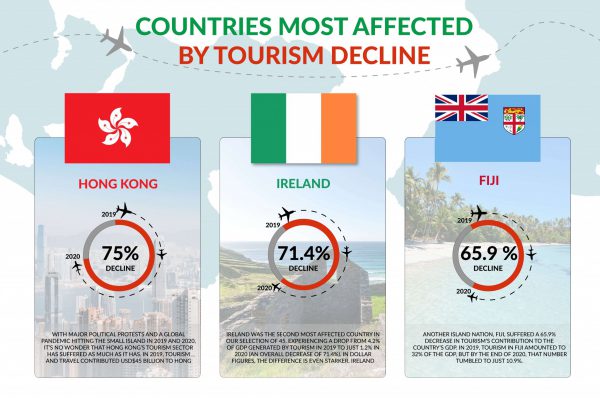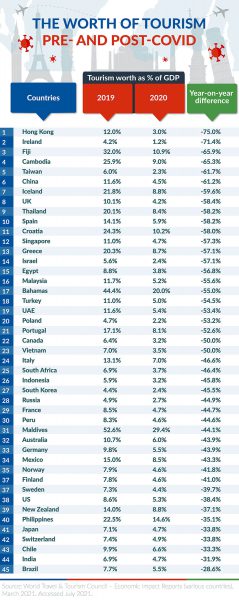SINGAPORE, 11 February 2022: A new tourism report by Compare the Market analysing 45 countries showed Hong Kong’s tourism industry suffered more than any other country during the pandemic, with a 75% drop in domestic and international travel between 2019 and 2020.
On the other hand, Brazil’s tourism industry was the least affected by the pandemic, with only a 28.6% drop year on year.

Global tourism has been crippled by the pandemic with border closures, quarantine rules and the threat of Covid-19 deterring would-be travellers the world over. New research by Compare the Market reveals which countries fared the worst and which ones survived.
Hong Kong was the most affected, with a 75% decline in its tourism industry from 2019 to 2020. In 2019, tourism and travel contributed USD45 billion to the country, which represented 12% of the GDP. This reduced to just 3% in 2020.
Ireland came off second worst with a 71.4% decline in tourism year-on-year, while Fiji rounded out the top three with a decrease of 65.9% in domestic and international travel.
Of the 45 countries observed, 23 saw their travel industry’s contribution to the national GDP cut in half in a single year, if not more.
Most island nations analysed (Fiji, the Bahamas, Maldives and the Philippines), which still experienced great drops in tourism, managed to keep their industry contributions (to the national GDP) above 10%.
The only mainland country that was able to replicate this feat was Croatia, which managed to maintain its tourism industry at 10.2% of the GDP in 2020 (down from 24.3% the previous year).
On the other end of the scale, Brazil’s tourism industry was the least affected, only suffering a 28.6% decline by going from 7.7% in 2019 to 5.5% in 2020.
India came out second-best with a total decline of 31.9% year-on-year, while Chile’s tourism industry went from being worth 9.9% of the national GDP in 2019 to 6.6% in 2020 (a decline of 33.3%).
New Zealand, the US and Australia were able to minimise the damage of the pandemic and keep the decline below 50%.
The results for these three countries are particularly surprising, given they were some of the first to implement restrictions on global air travel by early February 2020.
Keeping transmission low, nations like New Zealand and Australia were able to mitigate losses by driving domestic tourism – however, these campaigns were eventually hampered by border closures too.
For more information on which countries’ tourism industries were most and least affected by the pandemic, visit: https://www.comparethemarket.com.au/travel-insurance/features/the-worth-of-tourism/







